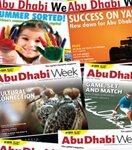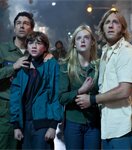The endangered Houbara bustard, the traditional quarry in Arabian falconry, is as integral to the sport as it is to the country’s heritage and culture. Abu Dhabi Week takes a tour of the National Avian Research Center in Sweihan to find out more about this fascinating bird

Over the last twenty to thirty years, the wild population of the Asian Houbara has become seriously threatened, mainly because of unregulated hunting, poaching and habitat loss as the country becomes more urbanised. In fact, according to international conservation standards, the Houbara is now classified as an endangered species.
Just over an hour’s drive from the centre of Abu Dhabi city, in the middle of the sandy expanse of Sweihan, sprawls the facilities of the National Avian Research Centre (NARC), one of the International Fund for Houbara Conservation (IFHC) centres, where extensive research and breeding programmes are being carried out with the aim of increasing Houbara Bustard numbers worldwide.
Established in 1989 after the late president of the UAE HH Sheikh Zayed bin Sultan Al Nahyan himself noticed the declining numbers of Houbara, NARC became operational in 1993 and started breeding attempts with donated birds. The first results of this conservation programme were seen in 2000, when 17 chicks were hatched in captivity and in 2004 the first five captive-bred Houbara were released into the wild. In 2006, the IFHC was established to oversee the research and this year the breeding production is expected to exceed 2,700 Houbara with about 1,000 birds being released into the wild by the end of the year.

After swapping our shoes for plastic sandals and donning green overalls, we step on disinfectant mats before entering the facility itself. We’ve been joined by two of NARC’s most knowledgeable staff, Tatiana Aponte (project coordinator) and Sophie Longuet (avian technician), who will be showing us around and answering any questions we may have.
We start in the central laboratory – effectively the hub of the whole operation. It is here that IFHC’s scientists can analyse samples to study and preserve the population’s genetic diversity with respect to geographic variations, which ensures genetic integrity and viability in the birds, both as captive-breeding stock and as candidates for release into the wild.
After another change of footwear and over more disinfectant mats, we are led into a room containing row upon row of large cages, which is where we get our first glimpse of the bird in the flesh.

The Houbara we are looking at have quite large bodies (think really big chicken) with long legs and slender necks. The male is typically heavier (about 2.2 kg) than the female (about 1.2 kg) with a speckled brown upper body and a creamy white chest.
Tatiana tells us that Houbara are naturally shy and sensitive but careful handling and constant monitoring of the ambient conditions mean that these birds don’t seem the least bit unsettled by our presence – in fact they seem more inquisitive than anything.
Male and female Houbara are kept in separate wings on either side of the central laboratory. The male’s semen is collected daily using an intricate process involving a dummy Houbara, then it is taken to the lab for analysis before the females are inseminated.

In the wild, Asian Houbara populations breeding in spring in Central Asia migrate south in autumn to spend winters in the warmest parts of their range, including most of the Arabian peninsula and Pakistan, before migrating back to their breeding sites in early spring. However, the carefully controlled conditions at NARC mean that the breeding season can be extended over a longer period.
A short drive to the next building and we see what happens to the eggs once they have been collected. Rows of incubators are spread out over three or four large rooms and they act almost like a production line, carefully controlling the temperature and humidity, as the eggs are moved from one machine to the next until they reach the hatching machines at the end of their incubation period, which is typically 23 days.
With over 2,500 Houbara in the centre, you might wonder where all the bird feed comes from. Well, the simple answer is that NARC produces most of it themselves – as we find out in the next leg of our tour. Huge temperature-controlled hangars house separate breeding programmes for crickets, mealworms and mice – tens of kilograms of each are produced daily with the sole purpose of providing sustenance for our feathered friends.
We finish with a drive around the numerous release pens that occupy most of the desert scrubland behind the compound. Five or six Houbara occupy each pen as they become acclimatised to the outside environment in preparation for their release later in the year.
All released birds will have a ring and about 20 percent of these birds will be tagged and fitted with satellite and radio transmitters so they can be tracked, providing valuable information about migration routes, survival rates, nesting sites and broods.
The current average survival rate for released birds is a little over 50 percent after one year in the UAE, much higher than survivals measured in release programmes of other birds, and this year 20 nests and broods have been found here in the wild.
In his 1977 book ‘Falconry As Sport: Our Arab Heritage’, the late Sheikh Zayed said: “Let the bustard, which fly as fast as the wind, fly away and return”. We can only hope that the work being carried out by NARC/IFHC ensures that this remains as true in the future as it was in the past.
The dance of life

One of the most extraordinary sights in Arabian wildlife is the courting dance of the male Houbara.
Sometimes described as a little like “a turkey trying to ride a bicycle”, the amorous avian fluffs out his neck feathers and throws back his head so that it is almost hidden inside a large ruff of black and white while he struts swiftly in a straight line or a circle.
After mating, the female leaves by herself to find an area to lay her eggs. Making a shallow hollow or “scrape” in the open ground, she lays between one and five eggs. The male takes no part in incubating the eggs, rearing or defending the young – his only contribution to breeding is mating with the female and, of course, that fantastic dance.
Wild Arabia

We were accompanied on our tour of the NARC facilities by Australian wildlife biologist and filmmaker Chadden Hunter, who was researching and filming possible subjects for the BBC’s upcoming three-part documentary series exploring the natural history and culture of the Arabian peninsula.
Scheduled for broadcast in early 2013, ‘Wild Arabia’ will be shot in high definition over the next 12 months with a large proportion of filming taking place in Abu Dhabi and the UAE.
What with dugongs, turtles and flamingoes, not to mention falcons and Houbara, there’s certainly plenty of material right on our doorstep and more than enough to keep Hunter pretty busy. As he himself says in his online blog: “Wild Arabia will keep me sandy and camel-sore for the next two years.”
We certainly can’t wait to see it!
Find out more…
If you’re interested in finding out more about the Houbara bustard then make sure you visit IFHC’s stand at the upcoming Abu Dhabi International Hunting & Equestrian Exhibition at ADNEC from Wednesday 14th to Saturday 17th September or contact Ms Delphine Delire, head of communications and PR for IFHC on This e-mail address is being protected from spambots. You need JavaScript enabled to view it
written by: Jon Muller





